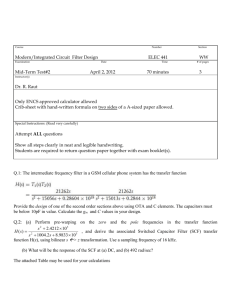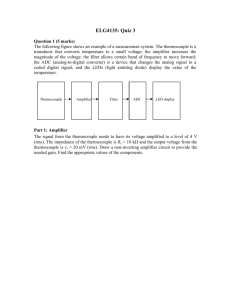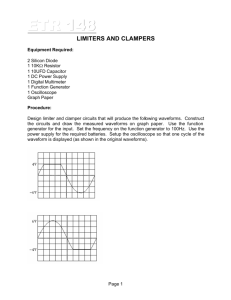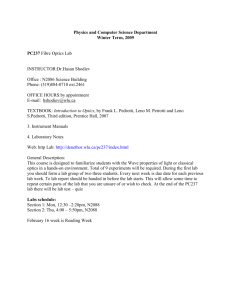PVI4_rc_filters
advertisement
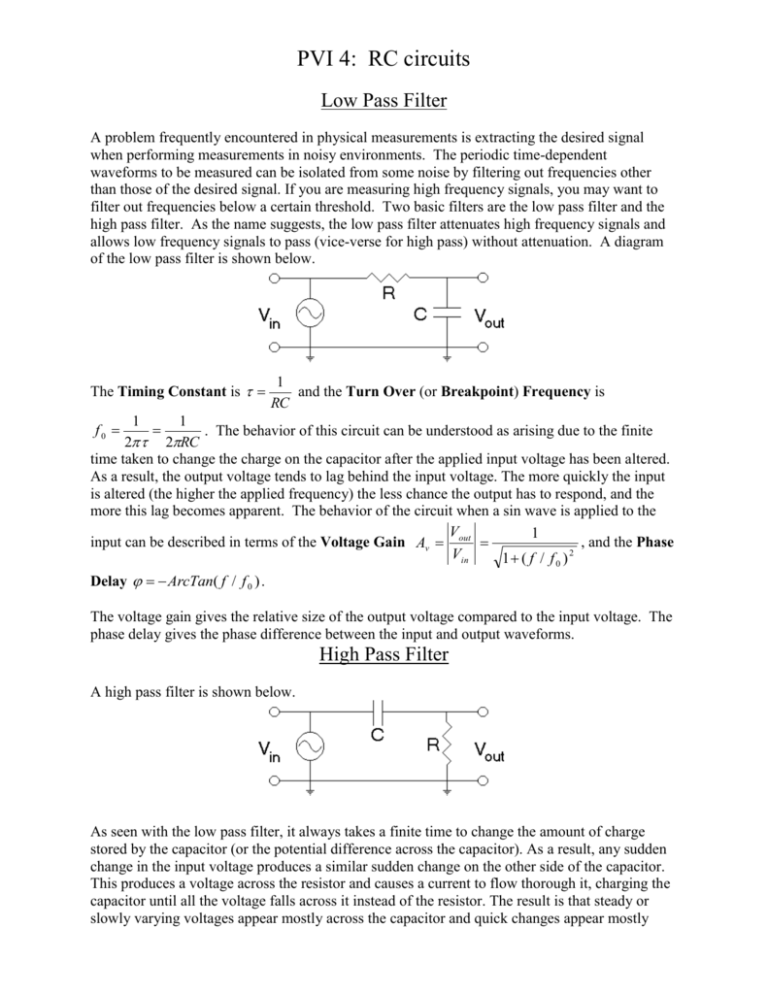
PVI 4: RC circuits Low Pass Filter A problem frequently encountered in physical measurements is extracting the desired signal when performing measurements in noisy environments. The periodic time-dependent waveforms to be measured can be isolated from some noise by filtering out frequencies other than those of the desired signal. If you are measuring high frequency signals, you may want to filter out frequencies below a certain threshold. Two basic filters are the low pass filter and the high pass filter. As the name suggests, the low pass filter attenuates high frequency signals and allows low frequency signals to pass (vice-verse for high pass) without attenuation. A diagram of the low pass filter is shown below. The Timing Constant is 1 . The behavior of this circuit can be understood as arising due to the finite 2 2RC time taken to change the charge on the capacitor after the applied input voltage has been altered. As a result, the output voltage tends to lag behind the input voltage. The more quickly the input is altered (the higher the applied frequency) the less chance the output has to respond, and the more this lag becomes apparent. The behavior of the circuit when a sin wave is applied to the V 1 input can be described in terms of the Voltage Gain Av out , and the Phase Vin 1 ( f / f ) 2 f0 1 1 and the Turn Over (or Breakpoint) Frequency is RC 0 Delay ArcTan( f / f 0 ) . The voltage gain gives the relative size of the output voltage compared to the input voltage. The phase delay gives the phase difference between the input and output waveforms. High Pass Filter A high pass filter is shown below. As seen with the low pass filter, it always takes a finite time to change the amount of charge stored by the capacitor (or the potential difference across the capacitor). As a result, any sudden change in the input voltage produces a similar sudden change on the other side of the capacitor. This produces a voltage across the resistor and causes a current to flow thorough it, charging the capacitor until all the voltage falls across it instead of the resistor. The result is that steady or slowly varying voltages appear mostly across the capacitor and quick changes appear mostly across the resistor. Since we're using the voltage across the resistor as the output, the gain and 1 phase delay of the high pass filter are: Av and ArcTan( f 0 / f ) . 1 ( f 0 / f ) 2 Procedure Assemble either of the filters discussed above on a prototyping breadboard. Use a resistor/capacitor combination that produces a turn over frequency near 1 kHz. The input voltages will be supplied by a function generator. Write a simple test vi that will allow you to capture a waveform at one of the analog inputs. Connect the function generator directly to an oscilloscope. Set the waveform to a sin wave. Calibrate the settings of the function generator by testing a few settings in the neighborhood of 1 kHz. Set the Vernier knob and multiplier on the function generator and measure the period, T in 1 seconds, on the oscilloscope. Find the frequency, f = in Hz, actually produced at that setting. T Measure the amplitude of the sin wave. The PCI 6024E data acquisition card can accept up to +/-10 V, but to be safe set the amplitude of the function generator to 4 V. Connect the function generator to the input of the filter and the oscilloscope to the output. Test a few input frequencies on either side of the turn over frequency and observe the amplitude of the output. Product 1: Simple input VI Identify the controls that produce a sinusoidal signal on the DAQ signal accessory, and monitor the output on the oscilloscope. Connect the signal generator to the R/C filter, and monitor the output of the filter on the scope. Good values for the components are R=10kohms, and C=0.005 microfarads. Disconnect the oscilloscope and connect the output of the filter to the data acquisition card, via the DAQ signal accessory. Create a VI that has the following features: -displays the signal coming from the output of the filter -has a control to change the sampling rate of the A/D convertor -verify that the amplitude changes with frequency Product 2: Filter Properites VI Modify your VI from Product 1 so that it partially automates the process of determining the filter properties. In order to accomplish this, you need to use functions to: -detect the peak voltage measured for each “sweep” at a given frequency -plot the peak voltage vs. the input frequency. Modify your VI so that it will take a sequence of measurements, each at a different input frequency (that you set by hand). You will need a “trigger” button or something like it to tell the VI when to take the next point. -Create a plot of peak voltage vs. frequency. Copy the image of the plot to the clipboard, paste it into MS-Paint, and save as a .jpeg file for submission to the instructor. IMPORTANT NOTE: In order for any of these procedures to work, the INPUT voltage from the signal generator must be constant during your measurement. You should check this with the oscilloscope.
